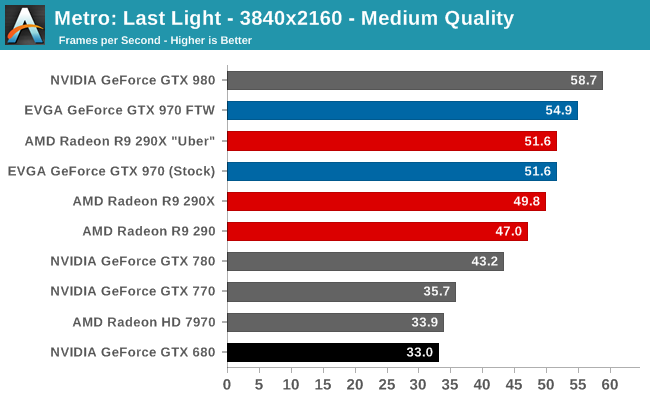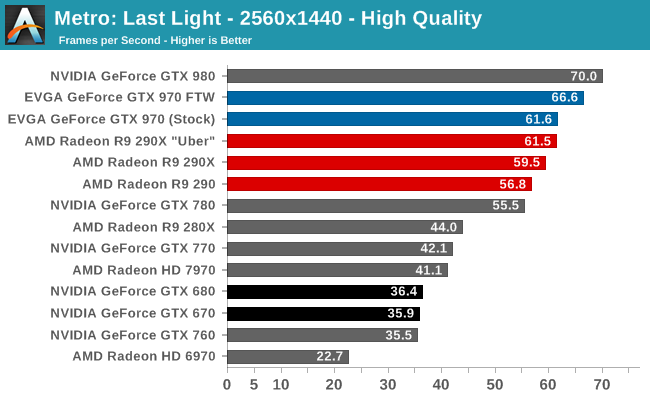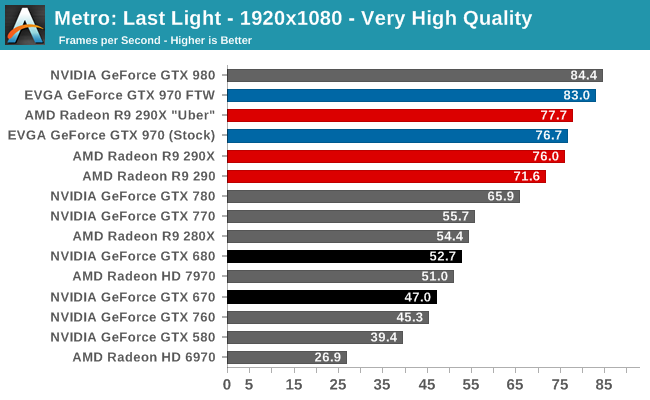The NVIDIA GeForce GTX 970 Review: Featuring EVGA
by Ryan Smith on September 26, 2014 10:00 AM ESTMetro: Last Light
As always, kicking off our look at performance is 4A Games’ latest entry in their Metro series of subterranean shooters, Metro: Last Light. The original Metro: 2033 was a graphically punishing game for its time and Metro: Last Light is in its own right too. On the other hand it scales well with resolution and quality settings, so it’s still playable on lower end hardware.



It seems fitting that we start with a game where the GTX 970 and R9 290XU start out tied. Even at the R9 290XU’s strongest hand – 4K – the GTX 970 is at parity and that remains for 1440p as well. Only at 1080p does the GTX 970 even begin to trail the R9 290XU.
This game ends up being a very good summary of what we’re going to see. The GTX 970 and R9 290XU trade blows from game-to-game, but in the end the two are a tie, just as we see here. Which for NVIDIA is a great outcome, as it means they’re tying a card that's nearly 50% more expensive.
Meanwhile if we push on the gas pedal a bit harder with the GTX 970 FTW, we see the EVGA card pull ahead of the R9 290XU and stock GTX 970 by 8%. This is a bit above average overall for the GTX 970 FTW, but it does conveniently highlight the fact that even if AMD officially pushed the clock speeds of R9 290XU a bit more, they’d still end up with GTX 970 right next to them.










155 Comments
View All Comments
AkibWasi - Saturday, September 27, 2014 - link
ain't those 896(64 per SMM) yellow colored boxes in Titan's diagram indicate FP64 cores ???Ryan Smith - Saturday, September 27, 2014 - link
Correct. NVIDIA only includes those cores on diagrams for their compute/pro GPUs.dexgen - Friday, September 26, 2014 - link
I think it would be a great idea to comment on and analyze the effects of overclocking (extra OC through AB or PX) when even the non overclocked settings end up getting throttled.For me, the most important thing about overclocking when the card is factory overclocked already is how much the throttling changes when the power target is increased. Any comments, Mr. Smith?
Ryan Smith - Friday, September 26, 2014 - link
Increasing the power target helps, but it does not fully alleviate the issue. A 10% increase just isn't enough to eliminate all TDP throttling, thanks in big part to the fact that power consumption grows with the square of the voltage. GM204 would ideally like quite a bit of power to sustain a heavy workload at 1.243v. Which is why that's officially in boost territory, as NVIDIA only intends that voltage/bin to be sustained in light workloads.Alexvrb - Saturday, September 27, 2014 - link
Wow I figured that the 970 would run into far less issues sustaining max boost than the 980. But I guess it is drawing nearly as much power. I don't want to see anyone complaining about AMD cards and boost anymore, heh.Anyway, the 970 still provides the absolute best bang for the buck and I'm stunned they didn't price it at $400. It's fast, reasonably priced, runs cool and quiet. It also is easy on power requirements, though I always overbuy on PSU anyway for headroom. Easy recommendation for anyone buying in the this price range!
AnnonymousCoward - Saturday, September 27, 2014 - link
Square of voltage, what are you smoking? P = IV = I^2 R = V^2 /R. The IC isn't a resistor. Typically current stays close to the same as you increase supply voltage.Ryan Smith - Saturday, September 27, 2014 - link
The formula for dynamic power consumption:P = C * V^2 * f
Where C is capacitance, f is frequency, and V is voltage. Those high boost bins are very expensive from a power standpoint.
AnnonymousCoward - Sunday, September 28, 2014 - link
You're right, thanks! Thinking about it, dynamic power increases by the square, and static is by a direct proportion, so total should be between the two. Dynamic probably dominates so it's probably much closer to the square.Footman36 - Friday, September 26, 2014 - link
What really bothers me is that EVGA is getting lazy, reusing older pcb's. This one looks like a 760... The VRM and phases look very primitive next to a card like the Asus Strix GTX 970. There was a time when EVGA used to wow me with custom designs, the last few years not so much as they invariably use reference boards. the issue I have with most of the reference boards is that coil buzz is noticeable. The Asus and MSI boards are using custom digital VRM's and super alloy caps....Anyhow, nice review.
Iketh - Monday, September 29, 2014 - link
i'm sure it has to do with their big heat sink design + bracing so the card doesn't flex